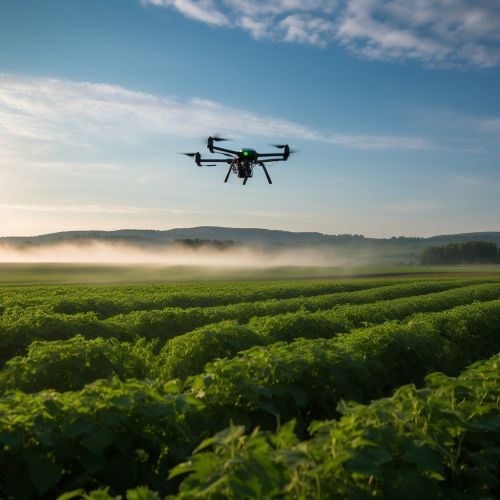Agricultural Drones
Introduction
Agricultural drones, also known as UAVs or ag drones, are becoming an increasingly important tool in the arsenal of farmers around the world. These drones are equipped with advanced sensors and digital imaging capabilities that allow farmers to monitor their crops and improve farm efficiency.


History and Development
The use of drones in agriculture began in the early 21st century, with the advent of more affordable and accessible drone technology. Initially, these drones were primarily used for crop surveillance, allowing farmers to monitor their fields more efficiently than traditional methods such as walking or driving through the fields. Over time, the capabilities of agricultural drones have expanded to include tasks such as crop spraying, planting, and livestock monitoring.
Types of Agricultural Drones
There are several types of drones used in agriculture, each with its own specific uses and benefits. These include:
- Fixed-Wing Drones: These drones are typically used for large-scale operations due to their ability to cover large distances quickly and efficiently. They are often used for crop surveillance and mapping.
- Multi-Rotor Drones: These drones are more versatile and can be used for a variety of tasks, including crop spraying and detailed crop monitoring.
- Hybrid Drones: These drones combine the benefits of fixed-wing and multi-rotor drones, offering both speed and versatility.
Applications of Agricultural Drones
Agricultural drones have a wide range of applications, including:
- Crop Surveillance: Drones equipped with high-resolution cameras and remote sensing technology can monitor crop growth, detect diseases, and identify areas of stress in the field.
- Crop Spraying: Drones can be equipped with sprayers to apply pesticides, fertilizers, and other treatments to crops. This method is often more efficient and precise than traditional methods.
- Planting: Some drones are capable of planting seeds, reducing the labor and time required for this task.
- Livestock Monitoring: Drones can be used to monitor livestock, track their movements, and detect any health issues.
Benefits of Agricultural Drones
The use of drones in agriculture offers several benefits, including:
- Increased Efficiency: Drones can cover large areas of land quickly, making them more efficient than traditional methods of crop monitoring and treatment.
- Precision Agriculture: Drones allow for precision agriculture, a farming management concept that uses drones to measure, observe, and respond to variability in crops.
- Reduced Labor Costs: By automating tasks such as crop surveillance and spraying, drones can reduce the need for manual labor, thereby reducing labor costs.
- Improved Crop Health: By detecting diseases and stress in crops early, drones can help farmers take corrective action sooner, leading to healthier crops and higher yields.
Challenges and Limitations
Despite the many benefits of agricultural drones, there are also several challenges and limitations to their use. These include:
- Regulatory Restrictions: In many countries, there are strict regulations governing the use of drones, which can limit their use in agriculture.
- High Initial Costs: While drones can lead to cost savings in the long run, the initial cost of purchasing and setting up a drone can be high.
- Technical Challenges: Operating a drone requires technical knowledge and skills, which can be a barrier for some farmers.
- Privacy Concerns: The use of drones can raise privacy concerns, particularly when they are used to monitor livestock or private property.
Future of Agricultural Drones
The future of agricultural drones looks promising, with advancements in technology expected to further increase their capabilities and applications. For example, the development of AI and machine learning technologies could enable drones to make autonomous decisions, such as identifying and treating crop diseases without human intervention. Additionally, improvements in battery technology could allow drones to operate for longer periods, increasing their efficiency and effectiveness.
